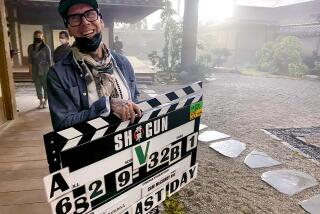Review: In documentary ‘Mifune: The Last Samurai,’ Spielberg, Scorsese and others shed light on the legendary Japanese actor
Toshiro Mifune was a name to conjure with.
A galvanic performer who was as present in his roles as anyone who ever lived, the legendary Japanese actor is the subject of “Mifune: The Last Samurai,” a smart and thoughtful examination of who the man was and how he got that way.
As directed by Oscar-winning documentarian Steven Okazaki, “Mifune” is thorough and insightful enough to enlighten the man’s numerous fans and serve as an introduction to those unfamiliar with his gifts and his influence, which were huge.
For, collaborating 16 times with the virtuoso director Akira Kurosawa, Mifune made not only some of cinema’s great landmarks, he created templates that had a major influence on American and world culture.
As narrator Keanu Reeves points out, there would be no “Magnificent Seven” without “The Seven Samurai,” no “A Fistful of Dollars” for Clint Eastwood without “Yojimbo,” no “Star Wars” for anyone without “The Hidden Fortress.”
(In good news for those wanting to see complete Mifune features on the big screen, a mini retrospective dedicated to the actor starts Dec. 3 at Laemmle’s Ahrya Fine Arts in Beverly Hills.)
Because Mifune died in 1997 and apparently did not give many on-camera interviews, he has been brought to life here not only through film clips but via a wide-ranging series of reflective, insightful interviews.
Though the speakers include American directors Steven Spielberg and Martin Scorsese, the best talk, not surprisingly, comes from Mifune’s Japanese collaborators, like the formidable Teruyo Nogami, who was Kurosawa’s script supervisor and worked on all 50 of his films over a decades-long span.
Just as compelling is sword-fighting choreographer Kanzo Uni, gray-haired but still active, who was killed by Mifune on-screen more than 100 times.
Though he became a Japanese icon, Mifune was in fact born in China’s Manchuria region to a Japanese couple, and did not even see the home country till he was drafted into the army at age 20, where mistreatment by officers fostered a rebellious streak that never left him.
While his career encompassed some 170 films -- including non-Japanese efforts such as “Grand Prix,” “Hell in the Pacific” and “Red Sun” -- Mifune started out eager to find a place in the camera department rather than wanting to be on the screen himself.
Mifune ended up in the most Japanese of genres, the samurai epics known as chanbara, costume dramas set in Japan’s feudal period when wandering swordsmen, invariably unemployed and impoverished, end up fighting for their own sense of justice.
There is a long and rich tradition of these films in Japan, and director Okazaki is especially strong in dealing with that history, featuring clips going back to the silent era and including a remarkable moment from a 1926 feature when a beleaguered warrior licks his opponents’ blood off his sword to re-energize himself.
Mifune never did anything that extreme, but his samurai roles were always memorable, including a scene from Hiroshi Inagaki’s “Samurai Trilogy,” in which he is quick enough to catch flies with his chopsticks.
The actor’s films with Kurosawa are of course his best known, and “The Last Samurai” reveals that the director, who could be a fierce taskmaster, in general never gave Mifune acting instructions, letting him develop his characters as he saw fit.
Giving insight into this complicated relationship, which ended in a split that has never been satisfactorily explained, are the two men’s sons, Shiro Mifune and Hisao Kurosawa. The younger Mifune also offers vivid memories of living with a father whose hobbies were apparently drinking and cars.
Though Mifune was an intensely masculine presence, it is the actresses who co-starred with him who prove to be the documentary’s secret weapon, offering vivid insights into his persona.
Yoko Tsukasa, who co-starred with Mifune 11 times, puts it poetically, saying, “He was like the ocean. The ocean is boundless but sometimes very turbulent.” The legendary Kyoko Kagawa, the star of such films as “Tokyo Story” and “Sansho the Bailiff,” is more direct. “He had a big presence, didn’t he?” she says. “There was no one like Mifune.”
===
No rating
Running time: 1 hour, 20 minutes
Playing Laemmle’s Ahrya Fine Arts, Beverly Hills
More to Read
Only good movies
Get the Indie Focus newsletter, Mark Olsen's weekly guide to the world of cinema.
You may occasionally receive promotional content from the Los Angeles Times.











